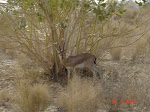The Lok Sabha poll was cononducted for barmer yesterday. interestingly, despite news of low poling throughout the country, the dstrict recorded nerly 53-54% polling when the summer heat was at its glory. The results would take some time to come out but this is an interesting and informative article i read in The Telegraph which i am pasting here for your reference. The article talks about the two main contestents from the district- harish Choudhary from congress and Manavendra Singh rom BJP.
Unusual eddy: minorities behind BJP nominee
CHARU SUDAN KASTURI IN BARMER
(Top) Children hold aloft BJP flags outside the election office of party candidate Manvendra Singh (above) in Barmer; Congress candidate Harish Choudhary (mike in hand, below) at a meeting in Bachrau
As the desert sand swept across National Highway 15, auto-rickshaw driver Taufiq Alam pulled over to one side and fished out a torn computer course certificate from a compartment under his seat.
“This is my brother’s certificate from his madarsa computer classes,” he said proudly, nodding in recognition at a passing SUV carrying the BJP flag. “That (the SUV) is a campaign vehicle for Manvendra Singh… it’s he who brought computers to madarsas,” Alam said.
Here in Barmer — made up of the two districts of Barmer and Jaisalmer and, at 55,074sqkm, India’s second-largest constituency by area — the Congress is fighting an unfamiliar battle.
It faces the challenge of eroding the Muslim vote bank of its opponent from the BJP, a party that usually succeeds in herding the minorities into the lap of the Congress elsewhere.
Manvendra, son of former NDA foreign minister Jaswant Singh who is contesting from Darjeeling, won a thumping victory in 2004 with 60 per cent of the votes, thanks to a role reversal.
He won 80 per cent of the votes from Muslim-dominated bastis (settlements) and villages, and the Congress was left licking its wounds in a constituency it had earlier lost just twice in 30 years.
This time, Manvendra’s fate may depend on how successfully the Congress can coax away his Muslim voters, veterans of both parties here say.
Muslims form the third-largest vote bank here with 1.98 lakh voters — 14 per cent of the constituency’s 14 lakh registered voters — after Dalits (2.36 lakh) and Jats (2.32 lakh).
Harish Choudhary, 38, a former Jodhpur University students’ union president, is the Congress candidate here. His supporters say he was nominated because of the popularity he had earned while working with victims of the freak floods that had turned this desert into a pool of death and disease three years ago.
Choudhary told The Telegraph that if he won, his priority would be to end caste-based politics — which he accused the BJP of promoting — in Barmer.
He and his supporters may be genuine in their convictions, but those in the Congress who pushed his candidature admit that it was his caste — Jat — that helped clinch the ticket for him.
After Dalits, Jats and Muslims, it is Rajputs — Manvendra’s clan — who are the largest group in this seat. But two key Assembly segments dominated by Rajputs have been de-linked from Barmer after delimitation and added to the Jodhpur constituency, where the Congress has fielded a Rajput.
“The transfer of the Rajput-dominated areas and the likely Jat vote for the Congress mean that the battle will really be over the Muslims,” a senior district BJP leader said.
Ashraf Ali, a local Muslim leader, said the Muslims had voted BJP in 2004 because they were angry with the Congress candidate, Colonel Sona Ram Choudhary. The colonel was perceived to have aided in the defeat of two Muslim candidates in the 2003 Assembly polls.
“This time, too, it is Manvendra who will win the Muslim votes, not the BJP, which is pariah for the community here as well,” Ali said.
Manvendra is claiming credit for the introduction of computers in madarsas, for the Thar Express which connects Munabao on India’s border with Kokhrapar in Pakistan, and for helping Muslims get Pakistani visas.
The Congress is trying to drill holes in these claims. “The Thar Express was started by the Manmohan Singh government. Why did the BJP not start it when Jaswant Singh was foreign minister?” asked Harish Choudhary.
In his sabhas in villages spread across the sparsely populated desert, Choudhary has repeatedly accused Manvendra of failing to raise a single question relating to Barmer’s needs and concerns in Parliament.
However, it is his call for votes “to end divisive politics along religious lines” at these sabhas that outlines the Congress’s desperation for Muslim votes.
Rajasthan votes on May 7
(taken from The Telegraph, Sunday, May 3rd)
दुष्यंत कुमार
16 years ago


